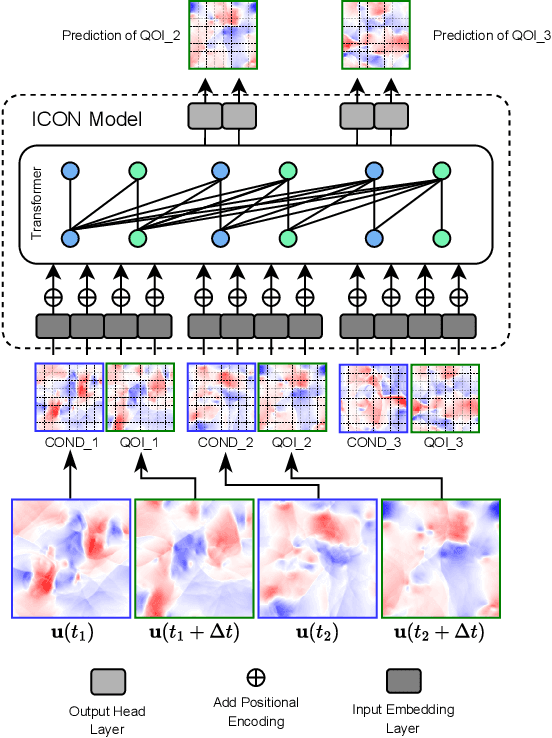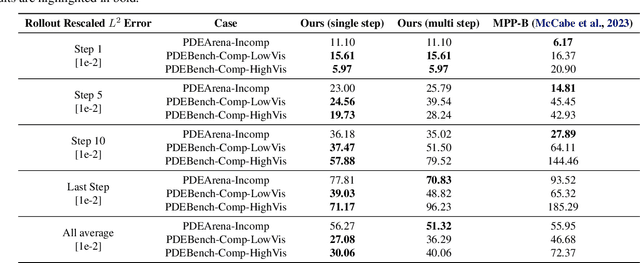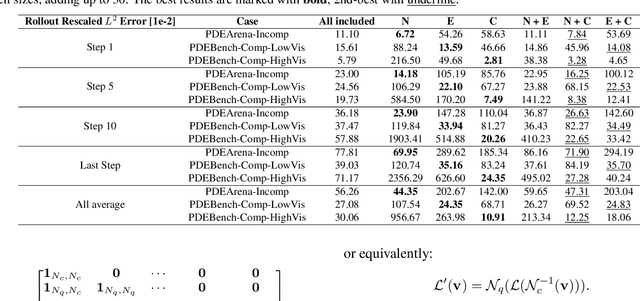Yuxuan Liu
HUAWEI
PEO: Improving Bi-Factorial Preference Alignment with Post-Training Policy Extrapolation
Mar 03, 2025Abstract:The alignment of large language models with human values presents a critical challenge, particularly when balancing conflicting objectives like helpfulness and harmlessness. Existing approaches, such as Reinforcement Learning from Human Feedback (RLHF) and Direct Preference Optimization (DPO), face notable limitations: RLHF suffers from instability and inefficiency in multi-objective optimization, while DPO lacks mechanisms for dynamic trade-offs. To address these challenges, we propose Post-Training Extrapolation Optimization (PEO), a novel and efficient framework for bi-factorial alignment. PEO generates a family of Pareto-optimal policies in a single training pass by leveraging a three-phase pipeline: (1) aspect-specific learning, (2) generalist initialization via interpolation, and (3) post-training optimization via extrapolation. PEO enables dynamic adaptation to diverse user preferences at inference time without retraining. Our comprehensive experiments across multiple LLMs demonstrate that PEO achieves superior Pareto fronts compared to baselines, offering improved flexibility and computational efficiency. Theoretical analyses further highlight PEO's capacity to overcome optimization bottlenecks, paving the way for scalable, personalized alignment.
MobileSteward: Integrating Multiple App-Oriented Agents with Self-Evolution to Automate Cross-App Instructions
Feb 24, 2025Abstract:Mobile phone agents can assist people in automating daily tasks on their phones, which have emerged as a pivotal research spotlight. However, existing procedure-oriented agents struggle with cross-app instructions, due to the following challenges: (1) complex task relationships, (2) diverse app environment, and (3) error propagation and information loss in multi-step execution. Drawing inspiration from object-oriented programming principles, we recognize that object-oriented solutions is more suitable for cross-app instruction. To address these challenges, we propose a self-evolving multi-agent framework named MobileSteward, which integrates multiple app-oriented StaffAgents coordinated by a centralized StewardAgent. We design three specialized modules in MobileSteward: (1) Dynamic Recruitment generates a scheduling graph guided by information flow to explicitly associate tasks among apps. (2) Assigned Execution assigns the task to app-oriented StaffAgents, each equipped with app-specialized expertise to address the diversity between apps. (3) Adjusted Evaluation conducts evaluation to provide reflection tips or deliver key information, which alleviates error propagation and information loss during multi-step execution. To continuously improve the performance of MobileSteward, we develop a Memory-based Self-evolution mechanism, which summarizes the experience from successful execution, to improve the performance of MobileSteward. We establish the first English Cross-APP Benchmark (CAPBench) in the real-world environment to evaluate the agents' capabilities of solving complex cross-app instructions. Experimental results demonstrate that MobileSteward achieves the best performance compared to both single-agent and multi-agent frameworks, highlighting the superiority of MobileSteward in better handling user instructions with diverse complexity.
BiDeV: Bilateral Defusing Verification for Complex Claim Fact-Checking
Feb 22, 2025Abstract:Complex claim fact-checking performs a crucial role in disinformation detection. However, existing fact-checking methods struggle with claim vagueness, specifically in effectively handling latent information and complex relations within claims. Moreover, evidence redundancy, where nonessential information complicates the verification process, remains a significant issue. To tackle these limitations, we propose Bilateral Defusing Verification (BiDeV), a novel fact-checking working-flow framework integrating multiple role-played LLMs to mimic the human-expert fact-checking process. BiDeV consists of two main modules: Vagueness Defusing identifies latent information and resolves complex relations to simplify the claim, and Redundancy Defusing eliminates redundant content to enhance the evidence quality. Extensive experimental results on two widely used challenging fact-checking benchmarks (Hover and Feverous-s) demonstrate that our BiDeV can achieve the best performance under both gold and open settings. This highlights the effectiveness of BiDeV in handling complex claims and ensuring precise fact-checking
A Multimodal PDE Foundation Model for Prediction and Scientific Text Descriptions
Feb 09, 2025Abstract:Neural networks are one tool for approximating non-linear differential equations used in scientific computing tasks such as surrogate modeling, real-time predictions, and optimal control. PDE foundation models utilize neural networks to train approximations to multiple differential equations simultaneously and are thus a general purpose solver that can be adapted to downstream tasks. Current PDE foundation models focus on either learning general solution operators and/or the governing system of equations, and thus only handle numerical or symbolic modalities. However, real-world applications may require more flexible data modalities, e.g. text analysis or descriptive outputs. To address this gap, we propose a novel multimodal deep learning approach that leverages a transformer-based architecture to approximate solution operators for a wide variety of ODEs and PDEs. Our method integrates numerical inputs, such as equation parameters and initial conditions, with text descriptions of physical processes or system dynamics. This enables our model to handle settings where symbolic representations may be incomplete or unavailable. In addition to providing accurate numerical predictions, our approach generates interpretable scientific text descriptions, offering deeper insights into the underlying dynamics and solution properties. The numerical experiments show that our model provides accurate solutions for in-distribution data (with average relative error less than 3.3%) and out-of-distribution data (average relative error less than 7.8%) together with precise text descriptions (with correct descriptions generated 100% of times). In certain tests, the model is also shown to be capable of extrapolating solutions in time.
BCAT: A Block Causal Transformer for PDE Foundation Models for Fluid Dynamics
Jan 31, 2025



Abstract:We introduce BCAT, a PDE foundation model designed for autoregressive prediction of solutions to two dimensional fluid dynamics problems. Our approach uses a block causal transformer architecture to model next frame predictions, leveraging previous frames as contextual priors rather than relying solely on sub-frames or pixel-based inputs commonly used in image generation methods. This block causal framework more effectively captures the spatial dependencies inherent in nonlinear spatiotemporal dynamics and physical phenomena. In an ablation study, next frame prediction demonstrated a 2.9x accuracy improvement over next token prediction. BCAT is trained on a diverse range of fluid dynamics datasets, including incompressible and compressible Navier-Stokes equations across various geometries and parameter regimes, as well as the shallow-water equations. The model's performance was evaluated on 6 distinct downstream prediction tasks and tested on about 8K trajectories to measure robustness on a variety of fluid dynamics simulations. BCAT achieved an average relative error of 1.92% across all evaluation tasks, outperforming prior approaches on standard benchmarks.
Automatically Planning Optimal Parallel Strategy for Large Language Models
Dec 31, 2024



Abstract:The number of parameters in large-scale language models based on transformers is gradually increasing, and the scale of computing clusters is also growing. The technology of quickly mobilizing large amounts of computing resources for parallel computing is becoming increasingly important. In this paper, we propose an automatic parallel algorithm that automatically plans the parallel strategy with maximum throughput based on model and hardware information. By decoupling the training time into computation, communication, and overlap, we established a training duration simulation model. Based on this simulation model, we prune the parallel solution space to shorten the search time required. The multi-node experiment results show that the algorithm can estimate the parallel training duration in real time with an average accuracy of 96%. In our test, the recommendation strategy provided by the algorithm is always globally optimal.
DeepSeek-V3 Technical Report
Dec 27, 2024



Abstract:We present DeepSeek-V3, a strong Mixture-of-Experts (MoE) language model with 671B total parameters with 37B activated for each token. To achieve efficient inference and cost-effective training, DeepSeek-V3 adopts Multi-head Latent Attention (MLA) and DeepSeekMoE architectures, which were thoroughly validated in DeepSeek-V2. Furthermore, DeepSeek-V3 pioneers an auxiliary-loss-free strategy for load balancing and sets a multi-token prediction training objective for stronger performance. We pre-train DeepSeek-V3 on 14.8 trillion diverse and high-quality tokens, followed by Supervised Fine-Tuning and Reinforcement Learning stages to fully harness its capabilities. Comprehensive evaluations reveal that DeepSeek-V3 outperforms other open-source models and achieves performance comparable to leading closed-source models. Despite its excellent performance, DeepSeek-V3 requires only 2.788M H800 GPU hours for its full training. In addition, its training process is remarkably stable. Throughout the entire training process, we did not experience any irrecoverable loss spikes or perform any rollbacks. The model checkpoints are available at https://github.com/deepseek-ai/DeepSeek-V3.
VICON: Vision In-Context Operator Networks for Multi-Physics Fluid Dynamics Prediction
Nov 25, 2024



Abstract:In-Context Operator Networks (ICONs) are models that learn operators across different types of PDEs using a few-shot, in-context approach. Although they show successful generalization to various PDEs, existing methods treat each data point as a single token, and suffer from computational inefficiency when processing dense data, limiting their application in higher spatial dimensions. In this work, we propose Vision In-Context Operator Networks (VICON), incorporating a vision transformer architecture that efficiently processes 2D functions through patch-wise operations. We evaluated our method on three fluid dynamics datasets, demonstrating both superior performance (reducing scaled $L^2$ error by $40\%$ and $61.6\%$ for two benchmark datasets for compressible flows, respectively) and computational efficiency (requiring only one-third of the inference time per frame) in long-term rollout predictions compared to the current state-of-the-art sequence-to-sequence model with fixed timestep prediction: Multiple Physics Pretraining (MPP). Compared to MPP, our method preserves the benefits of in-context operator learning, enabling flexible context formation when dealing with insufficient frame counts or varying timestep values.
Synth4Seg -- Learning Defect Data Synthesis for Defect Segmentation using Bi-level Optimization
Oct 24, 2024Abstract:Defect segmentation is crucial for quality control in advanced manufacturing, yet data scarcity poses challenges for state-of-the-art supervised deep learning. Synthetic defect data generation is a popular approach for mitigating data challenges. However, many current methods simply generate defects following a fixed set of rules, which may not directly relate to downstream task performance. This can lead to suboptimal performance and may even hinder the downstream task. To solve this problem, we leverage a novel bi-level optimization-based synthetic defect data generation framework. We use an online synthetic defect generation module grounded in the commonly-used Cut\&Paste framework, and adopt an efficient gradient-based optimization algorithm to solve the bi-level optimization problem. We achieve simultaneous training of the defect segmentation network, and learn various parameters of the data synthesis module by maximizing the validation performance of the trained defect segmentation network. Our experimental results on benchmark datasets under limited data settings show that the proposed bi-level optimization method can be used for learning the most effective locations for pasting synthetic defects thereby improving the segmentation performance by up to 18.3\% when compared to pasting defects at random locations. We also demonstrate up to 2.6\% performance gain by learning the importance weights for different augmentation-specific defect data sources when compared to giving equal importance to all the data sources.
Cerberus: Efficient Inference with Adaptive Parallel Decoding and Sequential Knowledge Enhancement
Oct 17, 2024



Abstract:Large language models (LLMs) often face a bottleneck in inference speed due to their reliance on auto-regressive decoding. Recently, parallel decoding has shown significant promise in enhancing inference efficiency. However, we have identified two key issues with existing parallel decoding frameworks: (1) decoding heads fail to balance prediction accuracy and the parallelism of execution, and (2) parallel decoding is not a universal solution, as it can bring unnecessary overheads at some challenging decoding steps. To address these issues, we propose Cerberus, an adaptive parallel decoding framework introduces the gating mechanism to enable the LLMs to adaptively choose appropriate decoding approaches at each decoding step, along with introducing a new paradigm of decoding heads that introduce the sequential knowledge while maintaining execution parallelism. The experiment results demonstrate that the Cerberus can achieve up to 2.12x speed up compared to auto-regressive decoding, and outperforms one of the leading parallel decoding frameworks, Medusa, with a 10% - 30% increase in acceleration and superior generation quality.
 Add to Chrome
Add to Chrome Add to Firefox
Add to Firefox Add to Edge
Add to Edge